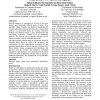Free Online Productivity Tools
i2Speak
i2Symbol
i2OCR
iTex2Img
iWeb2Print
iWeb2Shot
i2Type
iPdf2Split
iPdf2Merge
i2Bopomofo
i2Arabic
i2Style
i2Image
i2PDF
iLatex2Rtf
Sci2ools
TEI
2009
ACM
2009
ACM
Running up Blueberry Hill: prototyping whole body interaction in harmony space
Musical harmony is considered to be one of the most and technically difficult parts of music. It is y taught formally via abstract, domain-specific concepts, principles, rules and heuristics. By contrast, when harmony is represented using an existing interactive desktop tool, Harmony Space, a new, parsimonious, but equivalently expressive, unified level of description This focuses not on abstract concepts, but on concrete locations, objects, areas and trajectories. This paper presents a design study of a prototype version of Harmony Space driven by whole body navigation, and characterizes the new opportunities presented for the principled manipulation of chord sequences and bass lines. These include: deeper engagement and directness; rich physical cues for memory and reflection, embodied engagement with rhythmic time constraints; hands which are free for other simultaneous activities (such as playing a traditional instrument); and qualitatively new possibilities for collaborative use....
| Added | 19 May 2010 |
| Updated | 19 May 2010 |
| Type | Conference |
| Year | 2009 |
| Where | TEI |
| Authors | Simon Holland, Paul Marshall, Jon Bird, Nick Sheep Dalton, Richard Morris, Nadia Pantidi, Yvonne Rogers, Andy Clark |
Comments (0)

